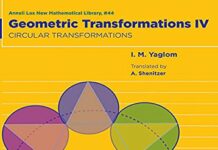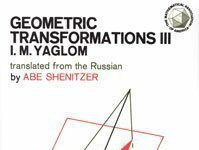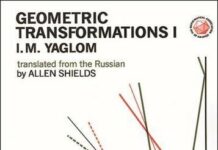
Ebook Info
- Published: 1979
- Number of pages: 307 pages
- Format: PDF
- File Size: 23.11 MB
- Authors: I.M. Yaglom
Description
There are many technical and popular accounts, both in Russian and in other languages, of the non-Euclidean geometry of Lobachevsky and Bolyai, a few of which are listed in the Bibliography. This geometry, also called hyperbolic geometry, is part of the required subject matter of many mathematics departments in universities and teachers’ colleges-a reflec tion of the view that familiarity with the elements of hyperbolic geometry is a useful part of the background of future high school teachers. Much attention is paid to hyperbolic geometry by school mathematics clubs. Some mathematicians and educators concerned with reform of the high school curriculum believe that the required part of the curriculum should include elements of hyperbolic geometry, and that the optional part of the curriculum should include a topic related to hyperbolic geometry. I The broad interest in hyperbolic geometry is not surprising. This interest has little to do with mathematical and scientific applications of hyperbolic geometry, since the applications (for instance, in the theory of automorphic functions) are rather specialized, and are likely to be encountered by very few of the many students who conscientiously study (and then present to examiners) the definition of parallels in hyperbolic geometry and the special features of configurations of lines in the hyperbolic plane. The principal reason for the interest in hyperbolic geometry is the important fact of “non-uniqueness” of geometry; of the existence of many geometric systems.
User’s Reviews
Reviews from Amazon users which were colected at the time this book was published on the website:
⭐This book does an excellent job of describing Galilean Geometry. I know of no other books on the topic, and this one was hard to find. It was used as a reference in an advanced mathematics course on geometries in 2010. There are a handful of points that were confusing in the text, but for the most part it is a fine book for self-study. There is an introduction, two main chapters on Galilean geometry, and a shorter final chapter on Minkowskian geometry. Each chapter ends with about twenty problems and several open ended challenge problems. About 25% of those problems have answers or hints in the back of the book, but they tend to be fairly cryptic. Pages 214-288 are three appendices describing a set of nine geometries to which the ones presented belong.The level of the text calls for a solid mastery of trigonometry, but requires no calculus, although a few limits appear in the appendices. Also required is a fair bit of mathematical insight and creativity. The subject is not for the faint of heart; of the several geometries studied in the course, this was by far the most involved. The book has particular appeal to physicists, as Galilean geometry is rarely even mentioned anywhere else, but is useful as a way of comparing classical and Einsteinian relativity.
⭐Galilean geometry is the study of the x-t plane under the motions that correspond to changes in time origin and change of uniform motion coordinate system. Although we introduce this geometry on physical grounds, we quickly move on to study this geometry in its own right without any physical motivation. Distance in Galilean geometry should mean distance in space and not in time so the distance between two points is the distance between their projections on the x-axis. Therefore circles in Galilean geometry are pairs of lines t=constant. The angle between two lines can be defined in terms of the section they cut out of a circle centred at their intersection, so in this way we have angles in Galilean geometry. But circles can also be defined in terms of angles: a moving point on a circle makes a constant angle with any two fixed points of the circle (half the central angle). Applying this definition in Galilean geometry gives a new type of curve which we call cycles. Circles and cycles together are in many ways the natural analog of Euclidean circles. We see this in particular when we study circle inversion. Euclidean circle inversion can be understood in terms of stereographic projection: put the plane tangent to the south pole and the eye at the north pole and project up on the sphere, then interchange the plane and the eye and project back. In Galilean geometry the sphere must be replaced by a cylinder (since, e.g., the center of the circle t=-c, t=+c is the line t=0 and thus maps to a line at infinity). In the chapter called “Conclusion” we look at how our ideas carry over to the geometry of space-time in special relativity, again without much concern for physics. As before, we use physics only to derive the motions of our geometry, in this case the Lorentz transformations, and then quickly go on to consider things of purely geometric interest. For instance, we see that the difference in signs between space and time components of a Lorentz transformation implies that a circle will be a hyperbola x^2-t^2=0 and the analog of stereographic projection requires a hyperboloid.
Keywords
Free Download A Simple Non-Euclidean Geometry and Its Physical Basis: An Elementary Account of Galilean Geometry and the Galilean Principle of Relativity (Heidelberg Science Library) in PDF format
A Simple Non-Euclidean Geometry and Its Physical Basis: An Elementary Account of Galilean Geometry and the Galilean Principle of Relativity (Heidelberg Science Library) PDF Free Download
Download A Simple Non-Euclidean Geometry and Its Physical Basis: An Elementary Account of Galilean Geometry and the Galilean Principle of Relativity (Heidelberg Science Library) 1979 PDF Free
A Simple Non-Euclidean Geometry and Its Physical Basis: An Elementary Account of Galilean Geometry and the Galilean Principle of Relativity (Heidelberg Science Library) 1979 PDF Free Download
Download A Simple Non-Euclidean Geometry and Its Physical Basis: An Elementary Account of Galilean Geometry and the Galilean Principle of Relativity (Heidelberg Science Library) PDF
Free Download Ebook A Simple Non-Euclidean Geometry and Its Physical Basis: An Elementary Account of Galilean Geometry and the Galilean Principle of Relativity (Heidelberg Science Library)


